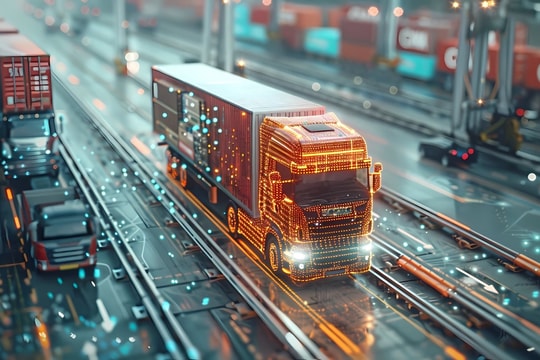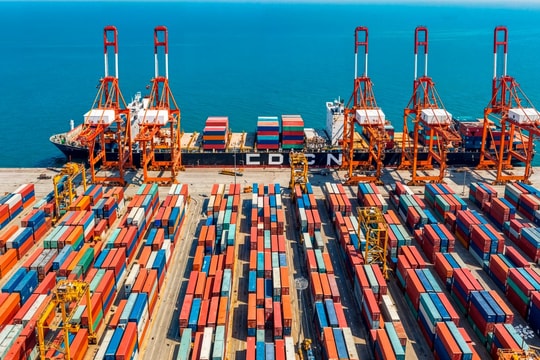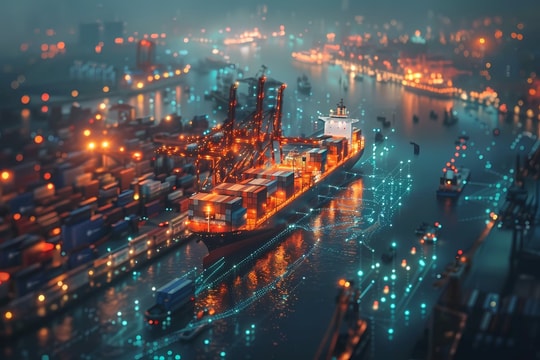
Vietnam, a country on the West coast of the East Sea with the coast of 3,444km in length and the territorial water of 1,278,000 km2, are now having 160 ports and 305 berths in operation with the total length of 36,164 km. Besides, Vietnam’s sea is located right on air and sea arterial routes connecting Pacific to Indian Ocean, and connecting Europe, and the Middle East to North East Asian countries. This busiest business area of Far East is on the way of 5 of 10 major global sea routes which annually transport 70% the amount of oil imported from Middle East and the South East Asia, and it is also on the way that 45% of imported/exported goods of Japan’s, and 60% of those of China’s are being transported through.
DEVELOPMENT PROGRESS OF VIETNAM SEAPORT SYSTEM
Vietnam sea ports started their development after 1975, and was growing rapidly in the period of innovation (in the late 1990s of the last century) based on the master plan of the Vietnam seaport system implemented by the Department of Maritime, belonging to the Ministry of Transport, with the consultancy from local and foreign experts and in accordance to proposals and requirements from different relevant sectors and local areas. The development can be divided into two periods:
The 1st period (2000-2010) with some major issues
1.There were inadequate construction and planning managements that led to the constructions of many small ports with low loading/unloading capacity (only ½ of capacity on average compared to those of regional ports), the lack of connection to the national transport network, and the lack of using multi modal transport. Consequently, the ports did not efficiently operate: they were always short of goods. Ports being constructed were surplus to regional areas’ requirements, leading to scattered investment and making a waste of national resources, and thus disabling the Government’s plan.
2.The lack of deep water ports, container terminals and international transshipment ports which enable to receive large vessels, mother vessels (with tonnage of 120,000 TEU and Panamax, Post Panamax vessels of 6,000-9,000TEU)
3.The forecast for cargo growth for Vietnam sea port system gave out inaccurate outcomes, which lead to inappropriate management and investment planning on sea port infrastructure. According to the forecast for planning till 2010, with orientation to 2020, in 2010 the throughput capacity of the nation’s sea port system could be around 100,000 million tons/year. But in fact, in 2006, the throughput had reached 154,5 million tons and in 2008, 210 million tons with the container tonnage of 5 million TEU. Therefore, the average growth in 10 years (2000-2010) was 10-12%/year. This means that the capacity of Vietnam sea port system should be 4 times greater and there should be an investment of 4 billion dollars for more ports to meet growing needs till 2020.
The second period (2010-2020 with vision till 2030) we have basically solved issues from the first period. Deep water ports, in joint-venture with foreign partners, will be built at relatively reasonable locations along the North-South coast; big cities as Ha Long, Hai Phong, Da Nang, Vung Tau and HCMC will be chosen to be regional centers to develop sea-based economy related businesses, connecting closely to the process of industrialization and modernization of the country. However, the sea-based economy model of Vietnam is relatively small in comparison with neighbor countries, only equal 24% of China, 14% of Korea, and 1% of Japan. There should be breakthroughs in coming decade to catch up with other regional countries.
There have been 5 deep water ports in operation on the rivers of Thi Vai and Saigon: Tan Cang-Cai Mep, SP-PSA, CMIT, CSG-SSA and SPCT in joint-venture or in coalition with foreign partners, forming the first Vietnam deep water sea port system which enable to receive large vessels and mother vessels going straight from Vietnam to Europe or North America, without transshipment at intermediate ports in Asia (Hong Kong, Kaohsiung, and Singapore), and shorten the transport time to 7-10days. This is an important event to the Vietnam maritime.
LESSONS FROM SEA PORT DEVELOPMENTS
A sea port system is an important infrastructure of a sea-based economy. Its huge asset can be utilized through many generations and can create prosperity for the country. Concerned people should draw out these following lessons:
1. Planning and management of planning implementation
All sectors need planning to develop. Planning is a macro strategy, a right orientation built on the basis of science and synchronization for sectors and regions, which count on business factors, regional conditions, and weather changes in a particular period. A wrong calculation in sea port planning will resulted in failure and waste, and the lack of synchronization will resulted in inefficient outcomes.
From scientific angle, the planning should be counted on these factors:
Supplies to calculate the port throughput – Ports can be built on the principle of supplies available, not on “workable ideas”
Geographical condition: Ports should be near to seas and navigation ways should be deep enough for vessels
The stable rear: Behind ports should be material-supplier areas or industrial parks that ensure stable supplies for ports to operate. At the same time, ports should be connecting with the traffic network to create a chain of transport. Sadly enough, in the first planning (1999-2010), the matter was not properly considered, causing issues and wastes for the country.
Another matter to be concerned is the planning implementation management, a weak part in the Government’s process. In many sectors, planners give out directions, but do not mention about the time of implementation or those who will implement the plan, which already resulted in “impossible missions”, for instance, Hai Ha port in Quang Ninh –once to be considered as the country’s largest port in scale; or some projects which has been suspended as Van Phong international transshipment port, Quan Chanh Bo navigation way to Cai Cui port, Hau Giang; and other planning projects which has been suspended due to the lack of investment capital or waiting for land hand-over.
Recently, there is the gloomy situation of newly-built ports in HCMC, Ba Ria-Vung Tau an Dong Nai:” In the second quarter 2012, container capacity through these ports reached only 1.76 million TEU, which is equal to 25% of that in 2011…”, which differs from the previous forecast of increasing 40%. Is it a warning signal of the same mistakes that we had made in the first planning of the Vietnam sea port system?
2. Training human resources in order to operate the sea port system effectively
According to the statistics, there are 53 million people in working age (63% of the population), but only 27% of them receive national standard training, 73% of them receive no or inappropriate training, especially in the field of sea-based economy, agriculture, and forestry. Vietnam’s labor efficiency is ranked 77/125 globally.
Resolution no.4, the 10th National Congress of the Communist Party of Vietnam stated clearly: “Sea-based and coast-based economy will contribute 53-55% the country’s GDP and 55-60% exports of the foreign trade”. To implement it, Vietnam should have a work force that is equipped with knowledge and working skills of global standards or, at least, of regional standards, especially that in sea ports areas. Therefore, Vietnam should have appropriate steps for human resources training especially in the fields of logistics, IT, electronics, and automation… and then we can have enough abilities to make good use of ocean engineering, coastal engineering, offshore engineering and sea environment engineering-the businesses that are popular and closely related to a sea port system.
3. Research and Development (R&B) to increase competitive abilities
R&D is an index not only to measure science-technology strength of a country but also to show the competitive advantages of the country’s economy or of a business in a market. Vietnam’s economy has integrated to the global economy, but it is considered having weak competitiveness, especially the state-owned sectors and businesses.
Investing in R&D is an important part in national branding strategy, and a driving force for business organizations to develop. In 2006, 1,000 billion dollars was spent on R&D globally; among which the U.S accounted for 1/3 of the total amount (Ford Motor Co., the U.S, ranked first with 8.6 billion dollars, Microsoft with 7.08 billion dollars ranked 5th and Samsung Electric Co., Korea ranked 9th with 5.85 billion dollars among 10 global big businesses) (From AP. European Commission).
While doing research on related matters of sea port developing, we found no business in Vietnam sea port system mentioned about R&D investment. And few Vietnamese businesses have considered this matter in the current situation of recession. But we do expect “after the storm comes the calm sea” and our sea-based economy and our sea port system will go far to a new stature in not-too distant future.


.png)





.png)
.png)





